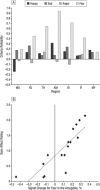Neuropsychiatric aspects of schizophrenia
- PMID: 21199445
- PMCID: PMC6493813
- DOI: 10.1111/j.1755-5949.2010.00220.x
Neuropsychiatric aspects of schizophrenia
Abstract
Cognitive and affective deficits are prominent clinical features of schizophrenia that impact functioning and are a challenge to effective treatment. The integration of functional magnetic resonance imaging (fMRI) with cognitive and affective neuroscience paradigms enables examination of the brain systems underlying domain-specific behavioral deficits manifested in schizophrenia. There has been a marked increase in the number of studies that apply fMRI in neurobiological studies of schizophrenia. This article highlights phenotypic features of schizophrenia that emerge from these studies and provides a neuropsychiatric perspective. Such efforts have helped elucidate potential neural substrates of deficits in cognition and affect in schizophrenia by providing measures of activation to neurobehavioral probes and connectivity among brain regions. Studies have demonstrated abnormalities at early stages of sensory processing that may influence downstream abnormalities in more complex evaluative functioning. The methodology can help bridge integration with neuropharmacologic, genomic, and neurorehabilitation investigations.
© 2010 Blackwell Publishing Ltd.
Conflict of interest statement
The authors have no conflict of interest.
Figures





Similar articles
-
Functional magnetic resonance imaging in schizophrenia.Dialogues Clin Neurosci. 2010;12(3):333-43. doi: 10.31887/DCNS.2010.12.3/rgur. Dialogues Clin Neurosci. 2010. PMID: 20954429 Free PMC article. Review.
-
Social-cognitive brain function and connectivity during visual perspective-taking in autism and schizophrenia.Schizophr Res. 2017 May;183:102-109. doi: 10.1016/j.schres.2017.03.009. Epub 2017 Mar 11. Schizophr Res. 2017. PMID: 28291690 Free PMC article.
-
Neuroimaging-genetic paradigms: a new approach to investigate the pathophysiology and treatment of cognitive deficits in schizophrenia.Harv Rev Psychiatry. 2006 Mar-Apr;14(2):78-91. doi: 10.1080/10673220600642945. Harv Rev Psychiatry. 2006. PMID: 16603474 Review.
-
What do we know about neuropsychological aspects of schizophrenia?Neuropsychol Rev. 2009 Sep;19(3):365-84. doi: 10.1007/s11065-009-9109-y. Epub 2009 Jul 30. Neuropsychol Rev. 2009. PMID: 19639412 Free PMC article. Review.
-
Aberrant intrinsic brain activity and cognitive deficit in first-episode treatment-naive patients with schizophrenia.Psychol Med. 2013 Apr;43(4):769-80. doi: 10.1017/S0033291712001638. Epub 2012 Aug 10. Psychol Med. 2013. PMID: 22883428
Cited by
-
Schizophrenia diagnosis and treatment.CNS Neurosci Ther. 2011 Apr;17(2):81-2. doi: 10.1111/j.1755-5949.2011.00250.x. CNS Neurosci Ther. 2011. PMID: 21401910 Free PMC article. No abstract available.
-
Attempts to replicate genetic associations with schizophrenia in a cohort from north India.NPJ Schizophr. 2017 Aug 30;3(1):28. doi: 10.1038/s41537-017-0030-8. NPJ Schizophr. 2017. PMID: 28855605 Free PMC article.
-
Age at Onset and Social Cognitive Impairment in Clinically Stabilized Patients with Schizophrenia: An Ecological Cross-Sectional Study.Iran J Psychiatry. 2018 Apr;13(2):84-93. Iran J Psychiatry. 2018. PMID: 29997653 Free PMC article.
References
-
- Kraepelin E. Dementia praecox and paraphrenia. Edinburgh : E. & S. Livingston, 1919.
-
- Bleuler E. Dementia praecox or the group of schizophrenias. New York , NY : International Universities Press, 1950.
-
- Heinrichs R. The primacy of cognition in schizophrenia. Am Psychol 2005;60:229–242. - PubMed
-
- Heaton RK, Gladsjo JA, Palmer BW, et al Stability and course of neuropsychological deficits in schizophrenia. Arch Gen Psychiatry 2001;58:24–32. - PubMed
-
- Cornblatt BA, Keilp JG. Impaired attention, genetics, and the pathophysiology of schizophrenia. Schizophr Bull 1994;20:31–46. - PubMed
Publication types
MeSH terms
Grants and funding
LinkOut - more resources
Full Text Sources
Medical

